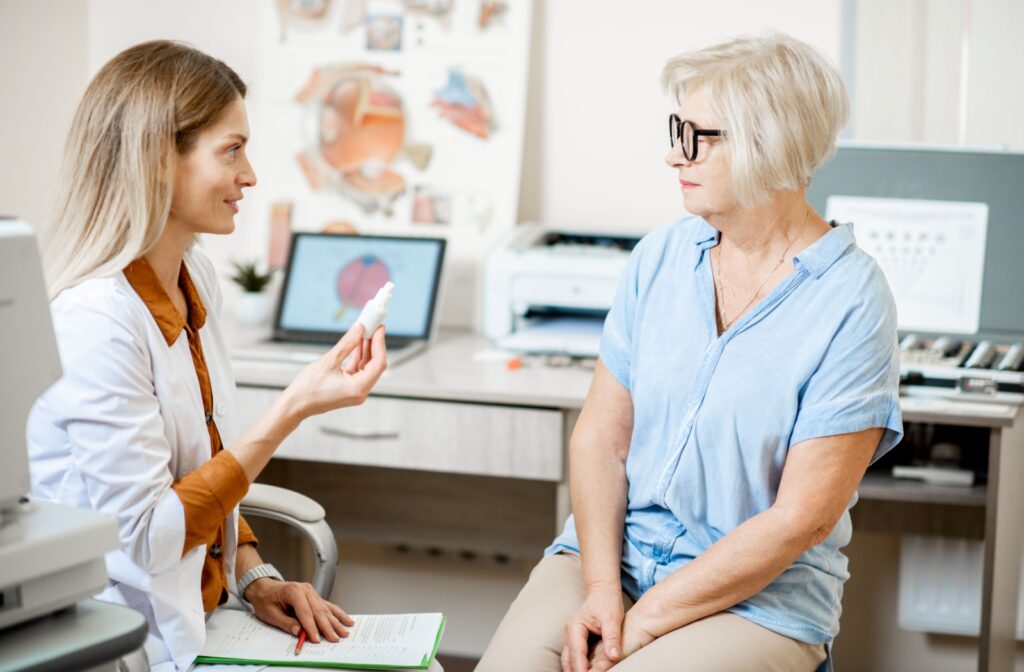If your eyes feel dry or irritated, you might instinctively blink more often to try and soothe the resulting discomfort. This makes sense! After all, blinking is the quickest way to refresh the tear film.
Each blink spreads a thin layer of tears evenly across your eye’s surface, keeping them moist and protected from irritants like dust and debris.
Blinking can temporarily relieve mild dryness, but it doesn’t always address the root cause of the discomfort. If your tear film isn’t healthy or your eyes aren’t producing enough moisture, blinking alone may not be enough to keep your eyes hydrated.
A dry eye consultation aids in understanding your dry eyes’ underlying cause, helping you find your way to long-term relief.
Blinking for Dry Eye Relief: It’s Complicated
For people with mild dryness, blinking may help redistribute the tear film, improving hydration for a short while.
For example, people who work long hours staring at a digital screen might develop dryness because they aren’t blinking enough. Simply becoming aware of how often you blink, actively blinking more during screen time, and taking frequent breaks from screens can sometimes alleviate those symptoms.
When you blink, the eyelid covers your eyes’ entire surface, replenishing the tear film and removing particles or irritants.
Blinking more can be an effective strategy for temporary dry eye relief for mild or situational cases if your tears are healthy but just need more coverage.
Why Doesn’t Blinking More Always Work?
Here’s where it gets tricky.
Dry eyes often result from an imbalance in the composition of your tears or issues with your meibomian glands.
The meibomian glands are tiny glands along the edges of your eyelids. They produce an oily substance composing one of the tear films’ three layers. This oil helps slow tear evaporation from the eye’s surface, keeping the eye hydrated for long periods.
When these glands become dysfunctional, a condition known as meibomian gland dysfunction (MGD); the lack of sufficient oil causes tears to evaporate too quickly, leading to dryness.
At the end of the day, if the tears themselves aren’t healthy or you’re not producing enough tears, simply blinking more won’t make much of a difference.
Think of blinking like trying to wipe a dry sponge across a counter; it’s not going to do much cleaning without water. If your tear film is missing important components, like enough oil to prevent rapid evaporation, blinking becomes less effective at providing the relief you’re looking for.
Additionally, some people with dry eyes experience inflammation on the eye’s surface, which blinking alone can’t resolve. Therefore, people with more moderate-to-severe dryness require a more comprehensive approach to dry eye relief.

Managing Dry Eyes
Here’s the thing about dry eye disease; it’s chronic and can’t be cured, but its symptoms are manageable with the right care. Blinking is just one piece of a much bigger puzzle for addressing and improving dry eyes.
If you’re living with dry eye symptoms, such as dryness, grittiness, watery eyes, or even discomfort and redness, the first step is scheduling a consultation with your eye doctor.
Understanding the root cause of your dry eye is key to developing a personalized management plan to improve your dry eye symptoms. During this visit, we’ll assess the health of your eyes and tear film and evaluate the severity of your symptoms and overall dryness.
For most people, managing dry eyes requires a multifaceted approach that combines lifestyle changes, home remedies, and advanced therapies for long-term relief.
Treatments for Dry Eye Relief
Here’s a quick breakdown of some of the most common therapies available today:
- Artificial tears: Over-the-counter lubricating eye drops can help provide immediate moisture for mild symptoms. They work by mimicking the composition of natural tears for added hydration.
- Warm compress masks: Warm masks can help soften blocks or clogs in oil-producing glands along the eyelids necessary for a healthy tear film. Wear the mask for at least 10 minutes and use your fingers to gently massage around the area to help improve oil gland function.
- Stay hydrated: Drinking plenty of water throughout the day helps maintain overall body hydration, directly supporting tear production and keeping your eyes moist. Adults should aim to drink at least 8 glasses of water daily.
- Prescription eye drops: Medications like Restasis, Xiidra, or Cequa reduce eye inflammation, helping to improve comfort and long-term tear production.
- Use a humidifier: Cold, arid, and windy environments can aggravate dryness. Adding moisture to your space with a humidifier is helpful indoors, as it can help reduce the evaporation of tears from the eyes.
- Take breaks from your work: Focusing on close-up work like reading, writing, or computer work for too long without frequent breaks leads to eye strain and reduces frequency of blinking. Practice the 20-20-20 rule and look at something 20 feet away for 20 seconds every 20 minutes.
- Avoid digital screens before bed: Limiting screen time in the evening reduces eye fatigue and supports natural tear film balance, promoting overall eye comfort.
Advanced Therapies for Dry Eye Relief
People with moderate to severe dry eye may require advanced therapies to target the root cause of the dryness.
Our team at InVision Eyecare offers several options for advanced dry eye therapies:
- Intense Regulated Pulsed Light (IRPL): This non-invasive device uses light pulses to stabilize the tear film by promoting oil production in meibomian glands.
- Punctal Plugs: These tiny plugs are inserted into your tear ducts to reduce tear drainage. They keep your natural tears on your eyes longer, thereby helping them stay hydrated.
- Meibomian Gland Expression: This treatment manually clears any blocks or clogs in your meibomian glands, allowing natural oils to flow into your tear film.
Take the First Step Toward Relief
Dry eyes can be annoying and frustrating. Depending on their severity, they can greatly impact your quality of life. Although blinking more may offer temporary relief, it doesn’t address the underlying cause of dryness.Connect with our InVision Eyecare team to schedule your dry eye consultation and take your first step toward dry eye relief.



